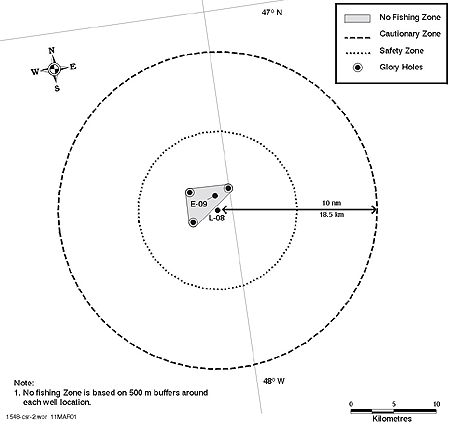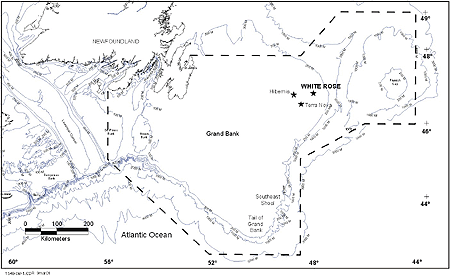Archived Content
Information identified as archived is provided for reference, research or recordkeeping purposes. It is not subject to the Government of Canada Web Standards and has not been altered or updated since it was archived. Please contact us to request a format other than those available.
Comprehensive Study Report
Assessment Methodology
- 3.1 Issues Scoping and Stakeholder Consultation
- 3.2 Valued Environmental Components
- 3.3 Boundaries
- 3.4 Effects Assessment Procedures
Assessment Methodology
Methods of effects assessment conform with the requirements of CEAA and its associated guidance documents (CEAA 1994a; 1997; 1998a; 1998b). They are generally comparable to those used in both the Hibernia (Mobil 1985) and Terra Nova (Petro-Canada 1995) EISs, and conform to the C-NOPB guidelines (C-NOPB 1988). Cumulative effects are incorporated within the procedures in accordance with CEAA (1994b; 1999) and as adapted from Barnes and Davey (1999). The specifications and spirit of the documents have been followed in conducting the assessment.
3.1 Issues Scoping and Stakeholder Consultation
The focus (or scope) of an assessment must be identified early in the environmental assessment process. The scope of the project to be assessed and the scope of factors to be considered are important for conducting an effective and efficient environmental assessment (CEAA 1998a). The components of the environment that are valued by society are the recommended focus of an assessment (Beanlands and Duinker 1983). These components are called Valued Environmental Components (VECs).
The proponents conducted an extensive issues scoping and stakeholder information/consultation program in relation to the White Rose oilfield development. This program allowed for the identification of the VECs that are the focus of the environmental assessment.
The scoping/consultation program involved:
- reviewing relevant legislation and guidelines;
- reviewing the scoping document issued by the C-NOPB, DFO, Environment Canada and Industry Canada;
- reviewing documents prepared for the Terra Nova and Hibernia oilfield developments;
- reviewing issues raised during the Terra Nova Development environmental assessment review process;
- consulting community, fishing, business, women's and non-governmental organizations, and the general public (key informant workshops, open houses and meetings/presentations);
- holding meetings with government departments and agencies;
- conducting media briefings and preparing press releases;
- tracking articles/stories from media sources;
- distributing project information (two mail distributions);
- establishing a project information telephone number (724-7244 and 1-877-724-7244);
- setting up a project-specific website (www.huskywhiterose.com);
- documenting issues and concerns, and following up when necessary; and
- using professional judgement based on the particular characteristics of the White Rose oilfield development.
The scoping/consultation program focused primarily on the areas most likely to be affected by the project. However, it also reached a geographically wider audience through meetings in other communities, with groups and organizations with a particular interest in the White Rose development, and through general solicitation of input from press releases, advertisements, the website and the project information telephone number at Husky Oil's St. John's office.
Further information on this public consultation program is provided in JWEL (2000). Comprehensive lists of the issues raised through the issues scoping and stakeholder consultation process, and included in the scoping document provided to the proponents by the C-NOPB, DFO, Environment Canada, and Industry Canada, are provided in the Comprehensive Study (Sections 1.2 and 1.5).
3.2 Valued Environmental Components
The VECs considered in the environmental and socio-economic assessment, as determined through the issues scoping exercise described above, are:
- fish and fish habitat;
- marine birds;
- marine mammals and sea turtles;
- business and employment;
- community infrastructure (social infrastructure and services; physical infrastructure); and
- fisheries.
These VECs were selected based upon expressed public concerns as well as previous project experience related to social, cultural, economic, or aesthetic values and scientific community concerns.
The commercial fishery is an acknowledged and important element in the society, culture, economic and aesthetic environment of Newfoundland and Labrador. The fish and fish habitat upon which the commercial fishery is based is a typical VEC assessed in an EIS for a project impinging on aquatic environments. Fish and fish habitat are considered as a single VEC, as they are clearly interrelated. This approach allows for a more comprehensive, ecosystem-based approach. Fish and fish habitat is of prime concern from both a public and scientific perspective, locally, nationally and internationally.
Newfoundland supports some of the largest seabird colonies in the world and the Grand Banks hosts very large populations during all seasons. They are important socially, culturally, economically, aesthetically, ecologically and scientifically. Also, this VEC is more sensitive to oil on water than other components of the environment.
Whales and seals are key elements in the social and biological environments of Newfoundland and Labrador. The economic and aesthetic importance of whales is evidenced by the large number of tour boats that feature whale watching as part of a growing tourist industry. Historically, seals have played an important economic and cultural role due to the large annual seal hunt. While sea turtles are scarce on the Grand Banks in general, they attain the status of a VEC because of their endangered and threatened status in Canada, the United States and elsewhere.
Business and employment are valued by individuals who may benefit directly or indirectly from work in its own right, changes in income and standards of living, and development of skills and expertise. New projects are generally beneficial from an economic perspective insofar as more people are employed, and successive rounds of employee and business expenditures generate employment and income multiplier effects in the local and provincial economies. However, particular socio-economic effects can be both positive and negative where different segments of society are differentially affected.
Local residents value infrastructure and services insofar as their quality and capacity in a community contribute to the overall standard of living and quality of life.
Commercial fisheries were also selected as a VEC because historically the fishery has played an integral role in Newfoundland and Labrador's economy, and has helped to define much of the province's character.
3.3 Boundaries
Effects are assessed for the three-year development phase to First Oil and the expected 12 to 14 year production lifespan of the White Rose Development. Effects that could continue after decommissioning are also considered. In addition, the potential effects of accidental events are assessed.
For the biophysical VECs (fish and fish habitat, marine birds, and marine mammals and sea turtles), the spatial boundaries used in the environmental assessment include the project area, the affected area, and a regional study area. The project area is that area directly disturbed by construction, installation, operation and related activities, including physical works (that is, locations of glory holes, production facility moorings, drilling unit moorings and subsea flowlines) and any vessel and/or fishery exclusion zones (Figure 3.1). The affected area, or that which could potentially be affected by project activities beyond the project area, was also considered in formulating effects predictions. These zones of influence (ZOI) were determined using comprehensive models of drill cuttings and produced water discharges (Comprehensive Study (Part One) Section 4.3.2). For accidental events, effects were assessed for areas potentially affected, as determined through oil spill modelling. (For detailed information on the drill cuttings, produced water and oil spill modelling exercises and predicted ZOIs, see Part One of the Comprehensive Study, Chapters 4 and 5). The regional study area, extending beyond the "affected" area, is considered to be the Grand Banks ecosystem (Figure 3.2). In addition, for each VEC there is a defined study area based on its specific nature and characteristics (Comprehensive Study (Part One, Chapter 3). These various spatial boundaries are described in more detail in the Comprehensive Study (Husky Oil 2000a; 2001a).


For the socio-economic VECs (business and employment, community social infrastructure and services, community physical infrastructure, and fisheries), the geographic scope of the assessment is primarily provincial, with more detailed studies of areas which may likely experience direct effects from the White Rose oilfield development. These areas include the St. John's Census Metropolitan Area, the Isthmus of Avalon area (an approximate 50-km zone centred on Bull Arm) and the Marystown area (a 50-km commuting zone from Marystown). Other communities, geographic areas, and administrative divisions are referred to as relevant. For example, for the fisheries VEC, fishing activity in Northwest Atlantic Fisheries Organization (NAFO) Divisions and Unit Areas adjacent to the White Rose project area is considered.
3.4 Effects Assessment Procedures
The approach used to assess the potential effects of the project involved:
- describing the existing environment;
- identifying potential interactions between the environment and the various phases and components/ activities associated with the proposed project;
- identifying and evaluating anticipated environmental effects;
- classifying anticipated environmental effects (adverse or positive);
- identifying mitigative measures;
- application of evaluation criteria for assessing environmental effects (magnitude, geographic extent, frequency, duration, reversibility, and ecological, socio-cultural and economic context);
- assessing cumulative environmental effects (considering those projects and activities that are ongoing or likely to proceed as outlined in the Responsible Authorities Guide (CEAA 1994b);
- assessing the residual environmental effects of the project after mitigation;
- determining the significance of predicted residual effects; and
- identifying follow-up initiatives.
In evaluating the predicted residual environmental effects of the project, an effect is rated as significant, not significant or positive. For fish and fish habitat, marine birds, and marine mammals and sea turtles, a significant effect is defined as one having a high or medium magnitude for a duration of greater than one year, over an area greater than 100 km². Magnitude was defined as follows (effects can be outright mortality, sublethal or exclusion due to disturbance):
- Low: Affects 0 to 10 percent of individuals in the area determined to be affected.
- Medium: Affects 10 to 25 percent of individuals in the area determined to be affected.
- High: Affects greater than 25 percent of individuals in the area determined to be affected.
For the socio-economic VECs, definitions for the rating criteria used differ between the fishery and other VECs because of the type, location and group of individuals affected. For example, magnitude is defined in terms of current capacity to accommodate change in the case of social and physical infrastructure and services, while in the case of the fishery, magnitude reflects the proportion of fishers affected by Project-related changes. For the business and employment and community infrastructure VECs, magnitude is defined as follows:
- Low: Within current capacity, standard or threshold.
- Medium: Approaches current capacity, standard or threshold.
- High: Exceeds current capacity, standard or threshold.
For the fishery, the magnitude of potential adverse effects is defined as follows:
- Low: Affects 0 to 5 percent of Grand Banks fishers.
- Medium: Affects 5 to 25 percent of Grand Banks fishers.
- High: Affects greater than 25 percent of Grand Banks fishers.
For each of the socio-economic VECs, an adverse residual effect is considered significant if it has a predicted magnitude of medium or high, and more so when its geographic extent or temporal nature increases, where it is irreversible, or when it occurs in an area previously unaffected by human activity. Geographic extent, duration, frequency, reversibility and context are each defined in ways relevant to the community related or fishery-related VECs.
The level of confidence for each residual effect prediction, and the likelihood of the effect occurring, are also indicated.
- Date Modified: